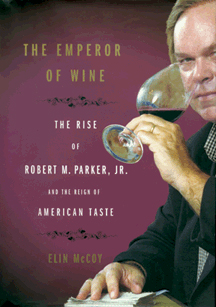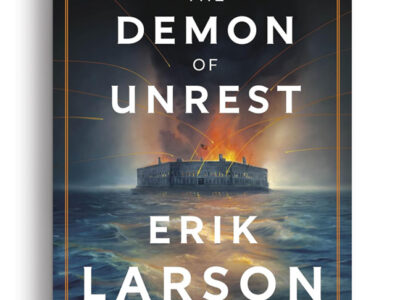The wine advocate and his empire.
By Samuel Hughes

THE EMPEROR OF WINE:
The Rise of Robert M. Parker, Jr. and the Reign of American Taste
By Elin McCoy CW’65.
HarperCollins, 2005. $25.95.
On March 21, 1983, a 35-year-old lawyer and semi-obscure wine writer named Robert Parker flew back to the United States after a week tasting barrel samples in the cellars of Bordeaux. As Elin McCoy CW’65 tells it, he was uncharacteristically anxious about the flight:
He wanted to lean forward in his seat, willing himself closer to the United States and the next issue of The Wine Advocate … Convinced that the red wines made in Bordeaux in 1982 … were “very great” and the vintage one of the finest of the twentieth century, he was panicky at the thought that if the plane went down he would miss his chance to write about it. He’d crammed his black notebook with notes on dozens of wines. Superlatives studded every page: “stunning,” “blockbuster,” “prodigious,” “incredible,” “fantastic,” “heavyweight,” and more. Parker was champing at the bit to let his readers in on what he considered the greatest wine buys since he’d started tasting wine in 1968.
Parker accurately predicted that that vintage would become one of the all-time greats, and his messianic promotion of it—combined with his growing reputation for sharp, independent analysis and his brilliantly marketable 100-point scoring system—would transform him into a figure of international clout. He was well on his way to becoming not just the most influential wine writer in the world—one whose verdicts could make or break wineries and whose stylistic preferences would alter the way many wines are made—but arguably the world’s most influential critic, period.
In The Emperor of Wine: The Rise of Robert M. Parker, Jr. and the Reign of American Taste, McCoy has written an important biography of Parker and the wine culture he helped transform. It’s a uniquely American story. Parker grew up drinking soda with dinner at his family’s ranch house in Monkton, Maryland, and his first wine experience involved a quantity of Cold Duck, which he barfed into his clothes drawer. He first fell in love with good wine on a 1967 trip to Europe to pursue his other passion, one Patricia Etzel (soon his wife), and by 1978 he was so obsessed with wine that he decided to publish his own newsletter. Originally called The Baltimore-Washington Wine Advocate, its logo was a corkscrew in the shape of a crusader’s cross. Parker, an early admirer of consumer advocate Ralph Nader, “kept that image of Nader and his philosophy firmly in mind” when honing his wine-writing philosophy.
McCoy, who has been writing about wine-related subjects for 30 years, has known Parker since 1981, and as an editor at Food & Wine magazine gave him his first national magazine assignment. The book is well researched and thoughtful, and her portrait of Parker is both sympathetic and clear-eyed. He comes across as an essentially decent, driven, talented man (McCoy is particularly taken with his love for Pat). That he succeeded beyond his wildest dreams is testament to his keen palate, his formidable powers of concentration, and his boundless energy and stamina—mandatory for someone who tastes 10,000 wines a year.
But she doesn’t airbrush out the warts, including his sense of near-papal infallibility and his often-paranoid response to reasonable criticism (usually accusing the critic of envy or some darker agenda). While she clearly believes in his basic honesty and independence, she also notes (for example) that the second issue of The Wine Advocate contained a flattering profile of two local wine merchants without mentioning that they had provided Parker with the mailing list he needed to launch the newsletter. She writes about his awards (including the French Legion of Honor in 1999) as well as the death-threats from coked-up wine merchants, and her coverage of such imbroglios as a 1994 lawsuit for defamation (filed against him by the Burgundy firm of Faiveley) seem quite balanced.
As the subtitle suggests, The Emperor of Wine is more than just a biography of le Grand Bob. It also chronicles the changing world of wine—especially the growing power of the American market—and Parker’s effect on it.
The “unique circumstances that coronated him will never be duplicated,” ” she suggests. And as rookie oenophiles began buying wine not by region or personal preference but by Parker score, “the question coming from the lips of many French producers, especially in Bordeaux, was a hand-wringing, ‘What should we do about Robert Parker?’”
Winemakers around the world saw that a high Parker score was money in the bank—for a top estate, “the difference between a score of 85 and 95 was 6 to 7 million Euros,” one Bordeaux négociant observed—and more than a few were willing and able to “Parkerize” their wines to suit his palate. “As dozens of winemakers told me,” McCoy reports, “‘If I want to make a 95 Parker wine, I know what I have to do.’” While some of the techniques are age-old—low yields in the vineyards, harvesting grapes as late as possible, no filtration in the winery—others (such as the use of micro-oxygenation to soften tannins and otherwise “speed up a wine’s evolution”) are new and highly sophisticated.
Even Parker’s effect on the lexicon of wine-writing is, in McCoy’s analysis, profound:
Parker employed a testosterone-charged vocabulary to describe the horsepower of wines: “big,” hefty,” “massive,” “huge,” “powerful,” “ferocious,” “prodigious,” “humungous” … and references to sex: “sexy,” “seductive,” “sensual,” “voluptuous,” even “liquefied Viagra.” … [B]y reframing the language of wine, Parker also subtly shifted what people were looking for; he reframed the picture of how they expected a good wine to taste. Vocabulary is never neutral; it carries an implication of quality. In Parker’s linguistic wine universe, “oodles of fruit” was singled out far more than subtlety.
Of course, not all of Parker’s readers bother with the prose, which is why his 100-point scoring system—actually a 50-point system, since it starts at 50—was so essential to his success. “Parker’s genius was to marry Americans’ love of numbers with their equal love of hedonism,” McCoy observes. She addresses the nettlesome question of how well anyone can authoritatively distinguish between an 85-point wine and one worth 86, but notes that “to him the difference was as obvious as short and tall suspects in a police lineup.”
McCoy admits to mixed feelings about Parker and his legacy. She admires his “quintessentially American” qualities—exuberance and passion; “that ruthless, action-oriented energy, the willingness to take on the establishment”; and “that openness and impulse to democracy, ready to back some little guy or new region that dreams of making something great and becoming a star.” She readily acknowledges that he has “helped to improve the quality of wines around the world by exhorting people to do better,” rewarding them with high scores when they do, and “castigating” those who make “industrial wines with little flavor and no authenticity.”
But, she adds: “Power always gives the opportunity to push too far, to dominate, to crush the opposition, all of which Parker has done, whether he admits to it or not.” She frets about the “tyranny of a single palate,” and worries that “wines with finesse and subtlety and savory, mouth-watering acidity” will be replaced by “thick, rich, fruity wines that are better in a blind tasting than they are on the table, with dinner.” The whole notion of scoring wine with numbers she regards as “a joke in scientific terms” and “misleading” in the way it “turns wine into a contest instead of an experience.”
Still, she concludes, Parker’s insistence that “no reputation, no matter how long-standing, can substitute for what can be found in the glass, his belief that there are still undiscovered wines and regions that can challenge the wine establishment, and his fundamental conviction that wine can be judged and rated like anything else are lasting contributions.”
A well-balanced offering, that.
In a former life, senior editor Samuel Hughes wrote about wine for The Philadelphia Inquirer, Philadelphia Magazine, and various national publications.




